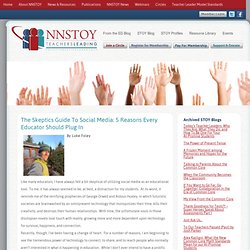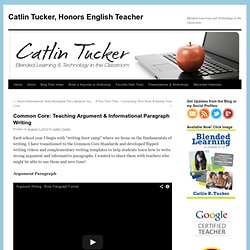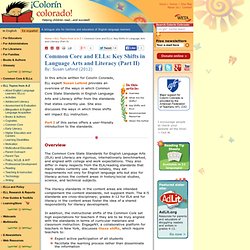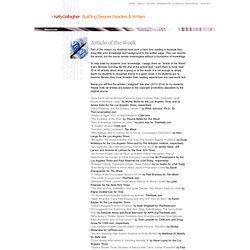

Google. National Network of State Teachers of the Year. By Luke Foley Like many educators, I have always felt a bit skeptical of utilizing social media as an educational tool.

To me, it has always seemed to be, at best, a distraction for my students. At its worst, it reminds me of the terrifying prophecies of George Orwell and Aldous Huxley, in which futuristic societies are brainwashed by an omnipresent technology that monopolizes their time, kills their creativity, and destroys their human relationships. With time, the unfortunate souls in those disutopian novels lose touch with reality, growing more and more dependent upon technology for survival, happiness, and connection. Recently, though, I’ve been having a change of heart.
So, here it is, the “Skeptics Guide to Social Media: 5 Reasons Every Teacher Should Plug In” 1. If even one of my students doesn’t have an online presence, I would be surprised. Now, I’m not saying to be Facebook friends with your students, or to adjust your days to make sure that you stay connected. 2. 3. 4. 5. National Network of State Teachers of the Year.
Common Core: Teaching Argument & Informational Paragraph Writing. Each school year I begin with “writing boot camp” where we focus on the fundamentals of writing.

Five close reading strategies to support the Common Core. I walked in to my first college class, Political Science 101, eager to learn.

For my inaugural college assignment, my professor asked the class to read the first three chapters of the textbook for the next class period. That night, I returned to my dorm room, determined to learn everything I could in those three chapters. I pulled out my textbook and highlighter. Growing up, that is what I always saw the “older kids” using when they read a textbook. In my naïve 18-year-old mind, I believed that highlighters must have some magical power that transports the words on the page directly to your brain. Nces.ed.gov/programs/slds/pdf/brief4_P_20W_DG.pdf. Teaching The N Word With Socratic Seminar. Key Shifts of the Common Core State Standards: English Language Arts and Literacy. Home > ELL Topics from A to Z > Common Core and ELLs: Key Shifts in Language Arts and Literacy (Part II) By: Susan Lafond (2012) In this article written for Colorín Colorado, ELL expert Susan Lafond provides an overview of the ways in which Common Core State Standards in English Language Arts and Literacy differ from the standards that states currently use.

She also discusses the ways in which these shifts will impact ELL instruction. Part I of this series offers a user-friendly introduction to the standards. Overview The Common Core State Standards for English Language Arts (ELA) and Literacy are rigorous, internationally benchmarked, and aligned with college and work expectations. The literacy standards in the content areas are intended complement the content standards, not supplant them.
In addition, the instructional shifts of the Common Core set high expectations for teachers if they are to be truly aligned with the standards in terms of curricular materials and classroom instruction. Steal These Tools. Kelly Gallagher – Resources. Part of the reason my students have such a hard time reading is because they bring little prior knowledge and background to the written page.

They can decode the words, but the words remain meaningless without a foundation of knowledge. To help build my students’ prior knowledge, I assign them an "Article of the Week" every Monday morning. By the end of the school year I want them to have read 35 to 40 articles about what is going on in the world. It is not enough to simply teach my students to recognize theme in a given novel; if my students are to become literate, they must broaden their reading experiences into real-world text.
Below you will find the articles I assigned* this year (2013-2014) to my students. "How Earth Got Its Tectonic Plates/On Saturn's Moon Titan, Scientists Catch Waves in Methane Lakes" by Monte Morin for the Los Angeles Times and by Amina Kahn for the Los Angeles Times, respectively "Hard Evidence: Are We Beating Cancer? " Writing to Inform and Make Arguments. Www.corestandards.org/assets/Appendix_B.pdf.
Text Complexity: Simplifying Text Complexity And The Common Core. New Series - Let's Chat Core. We hear from teachers every day here at Teaching Channel.

Without fail, the most frequent questions and requests have something to do with the Common Core State Standards. In a recent Tchers’ Voice survey we asked you to share your most pressing questions about the Core. We’ve compiled these questions and we are making a four-month commitment to bring you a steady stream of information and new resources, designed with your needs in mind. I’m looking forward to answering your questions and curating resources that help support your ongoing Core shifts. You can expect to find resources in many ways: You’ll get access to short video webinars where I unpack different facets of the CoreI’ll answer many of your questions in regular blog postsI’ll address some Core questions through brief podcastsWe’ll direct you to specific core-aligned videos from our library, often with my commentary in the Notes section Learning to Read the Core: A View from 30,000 Feet.